Spring Carnival Booths
April 2000 - April 2006Client: Alpha Epsilon Pi
Overview
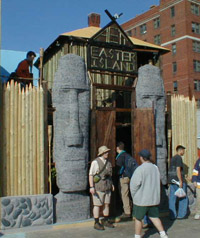
A booth I worked onA key component of Carnegie Mellon's annual Spring Carnival is the midway where various student organizations build themed carnival booths.
Booth at night There is an overall theme which each booth's design should represent. Each booth is intricately decorated and provides a game for guests to play. I have been involved in the design and fabrication of eight booths over seven years, several that I feel are of note.
2001: The Outer Realm
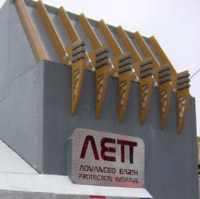
2001 Booth ExteriorIn 2001, our goal was to fully immerse our guests into an adventure of "larger than life" proportions. Admitted in groups of five, handed lab coats, and required to agree to non-disclosure, our guests found out that they were the newest trainees of a secret division of NASA researching ways to protect the Earth through the use of enlargement. Suddenly, during their orientation an asteroid is discovered on an imminent collision course with Earth and they, themselves, must be enlarged and used to destroy the asteroid fragments. This level of integration of guests, actors, and game into a cohesive story was unprecedented in the history of CMU carnival booths. Typically guests wander freely through the booth admiring the craftswork of students as members of the organization direct them to play a mildly themed version of a traditional carnival game.
I was the principle game designer and programmer. For the game this year I was responsible for overseeing several other people who were working on the graphical assets, sound, and physical interfaces. I did all the programming for the game itself as well as the tracking system responsible for the input. Guests aimed wireless toy guns at our screen, a project on part of a wall meant to be a seamless continuation of a painted starfield, and when the trigger was pulled the guns emitted a short laser pulse that was detected by an optical tracking system. Also that year I spent a dozen hours in character operating the second half of the experience.
2002: Batman
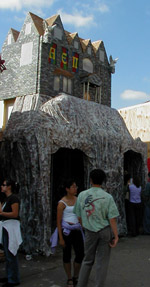
Wayne ManorIn 2002, we continued our passion for immersive storytelling with our Batman themed booth. Upon entering the Bat Cave, Alfred informed guests that Batman had been poisoned by the Penguin whose hench-penguins were terrorizing Gotham City. On a recreation city street, guests would take control of a life-sized Batmobile to search a virtual Gotham City for the antidote. The virtual city was projected onto the wall in front of the car so that it appeared as an extension of the real street that the car was positioned on. It followed a circular course across commercial and residential neighborhoods, a park, a suspension bridge, an elevated roadway, and finally a tunnel before coming to rest where it began inside the booth itself.

Virtual Gotham CityAgain, this year I was the lead game designer and programmer. Contracting out the 3D modeling and painting work, I oversaw the creation of the virtual city according to my level design. I did all the programming of the game itself as well as integration with several physical devices such as the steering wheel and pedals, working analog and digital speedometers, and a variety of effects including wind, rumble, and light when the Batmobile was "in motion".
2003: The Exodus from Egypt
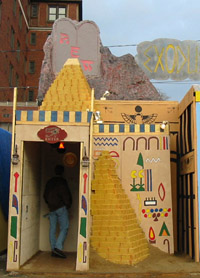
2003 Booth ExteriorFor 2003, I was the project manager for the entire attraction, responsible for overseeing all aspects of the project including design, approval, training, construction, budget, operation, and cleanup. I had to coordinate a team of roughly 30 people to divide up the various tasks needed to complete the booth on schedule for the carnival opening. There was a list of 28 individual projects whose status I needed to monitoring. I also programmed our microcontroller-based game capable of standing up, pulling down, and detecting hits on bean bag toss targets.
2005: How Aviation Works
In 2005, I was in more of a support and mentorship role for the organization I had traditionally worked with. However I still ended up doing a lot of the initial structural construction and also built two games. I built an air traffic control game, purely because I had always wanted to do so. However, I knew that the booth really needed something more simple and casual as the main game to be accessible to a wider audience. I was tasked with programming a flight simulator, but I had encouraged some younger members of the organization to tackle the design and 3D modelling. That unfortunately fell through, so at the last moment, I came up with a compromize that I could model and program myself in the time remaining. The end result was a model plane flight simulator, modeled using photographs to be able to fly around the rest of the carnival midway. Additionally, at the same time was also co-project manager for a smaller booth being built by a class I was taking.
2006: Ancient Aztecs
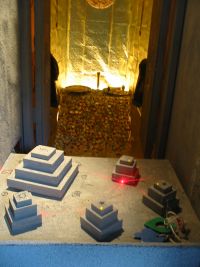
Aztec Puzzle GameFor the 2006 booth I assisted in the design, programming, and wiring of an electro-mechanical puzzle game. Although it was a small table-top game, it was modeled after the kind of puzzles seen in Indiana Jones-style movies. You had to find the appropriate key and place it in a slot, rotate a series of model pyramids to align lasers, and match symbols on the wall to ones on the table. Successfully completing the puzzle would open a hidden door in the wall revealing a themed treasure room.
Videos
 Booth 2001 Walkthrough |
 Booth 2002 Game |
















